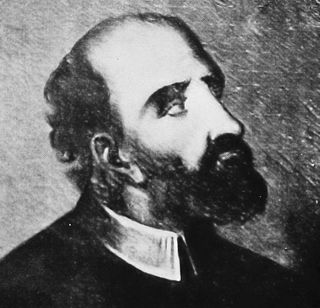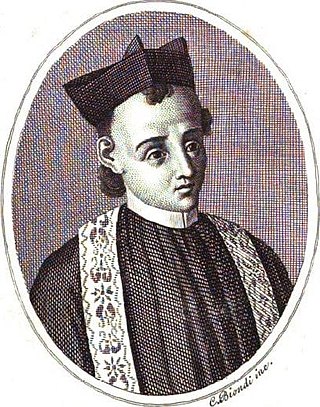Related Research Articles

Giovanni Animuccia was an Italian composer of the Renaissance who was involved in the heart of Rome's liturgical musical life. He was one of Giovanni Pierluigi da Palestrina's most important predecessors and possibly his mentor. As maestro di capella of St Philip Neri's Oratory and the Capella Giulia at St Peter's, he was composing music at the very center of the Roman Catholic Church, during the turbulent reforms of the Counter-Reformation and as part of the new movements that began to flourish around the middle of the century. His music reflects these changes.

Francesca Caccini was an Italian composer, singer, lutenist, poet, and music teacher of the early Baroque era. She was also known by the nickname "La Cecchina", given to her by the Florentines and probably a diminutive of "Francesca". She was the daughter of Giulio Caccini. Her only surviving stage work, La liberazione di Ruggiero, is widely considered the oldest opera by a woman composer. As a female composer she helped to solidify the agency and the cultural and political programs of her female patron.

Tarquinio Merula was an Italian composer, organist, and violinist of the early Baroque era. Although mainly active in Cremona, stylistically he was a member of the Venetian school. He was one of the most progressive Italian composers of the early 17th century, especially in applying newly developed techniques to sacred music.

Giovanni Pietro Bellori, also known as Giovan Pietro Bellori or Gian Pietro Bellori, was an Italian art theorist, painter and antiquarian, who is best known for his work Lives of the Artists, considered the seventeenth-century equivalent to Vasari's Vite. His Vite de' Pittori, Scultori et Architetti Moderni, published in 1672, was influential in consolidating and promoting the theoretical case for classical idealism in art. As an art historical biographer, he favoured classicising artists rather than Baroque artists to the extent of omitting some of the key artistic figures of 17th-century art altogether.

Giovanni Battista Paggi was an Italian painter, sculptor, and writer. His style spans the Late-Renaissance and early-Baroque.
Events from the year 1613 in art.
Events from the year 1563 in art.

The Lives of the Most Excellent Painters, Sculptors, and Architects, often simply known as The Lives, is a series of artist biographies written by 16th-century Italian painter and architect Giorgio Vasari, which is considered "perhaps the most famous, and even today the most-read work of the older literature of art", "some of the Italian Renaissance's most influential writing on art", and "the first important book on art history".

Giovanni Maria Verdizotti was a well-connected writer and artist who was born in Venice in 1525 and died there in 1600.
Alessandro Borgia was an Italian bishop and archbishop.

The Accademia delle Arti del Disegno is an academy of artists in Florence, in Italy. It was founded on 13 January 1563 by Cosimo I de' Medici, under the influence of Giorgio Vasari. It was initially known as the Accademia e Compagnia delle Arti del Disegno. It was made up of two parts: the company was a kind of guild for all working artists, while the academy was for more eminent artistic figures of the Medici court, and supervised artistic production in the Duchy of Florence.
Carlo Milanuzzi was an Italian composer of the early Baroque era.
Nicolò Corradini, was an Italian composer and organist of the early Baroque.
Meo Abbracciavacca was an Italian poet from Pistoia who died in 1313. Dante Gabriel Rossetti translated two of Abbracciavacca's poems into English in his work titled The Early Italian Poets From Ciullo D'Alcamo to Dante Alighieri (1100-1200-1300): Canzone. He will be silent and watchful in his Love and Ballatta. His Life is by Contraries.
Eros e Priapo: da furore a cenere is a 1945 satiric pamphlet by Italian author Carlo Emilio Gadda.

Il Primo Libro delle Canzoni is a collection of instrumental Baroque canzonas by the Ferrarese organist and composer Girolamo Frescobaldi. It was published in two different editions in Rome in 1628, and re-issued with substantial revisions in Venice in 1634. The three editions of the Primo Libro contain a total of forty-eight canzonas for one, two, three or four instrumental voices in various combinations, all with basso continuo; as a result of revisions, sixteen of the canzonas exist in two substantially different versions.
Maria Angelica Razzi was an Italian sixteenth century nun and sculptor at Santa Caterina da Siena in Florence. She primarily worked in clay to make devotional terracotta figures.
Giuseppe Ceccherini was an Italian composer and singing teacher. He was born in Florence, the son of Ferdinando Ceccherini (1792–1858), a noted tenor, composer, and the maestro di cappella of Florence's principal cathedral, Santa Maria del Fiore.

The Libro de' Disegni was a collection of drawings gathered, sorted, and grouped by Giorgio Vasari whilst writing his Lives of the Most Excellent Painters, Sculptors, and Architects. By the time of his death in 1574 it is thought to have contained around 526 drawings, of which 162 are now in the Louvre and 83 in the Nationalmuseum, Stockholm. There are also drawings from the Libro in the prints and drawings departments of the Uffizi, the British Museum, the Albertina, the National Gallery of Art and other institutions.

Tommaso Aversa was an Italian Baroque poet and playwright.
References
- ↑ Apel, Willi (1969). Harvard dictionary of music. Harvard University Press. p. 464.
In the second half of the 16th century Fra Serafino Razzi inaugurated a vast literature of laude in the popular styles of the villanella and canzonetta [ex. by G. Animuccia in SchGMB, no. 120]. Frequently, folksongs and dance melodies were used with the religious texts
- ↑ Garriott, Anita (1973). Fra Serafino Razzi and his laude collections of the sixteenth century.
- ↑ Sorella, Sergio (2009). "Tra sviluppo e decadenza". Termoli. Donzelli: 418. ISBN 9788860363718.